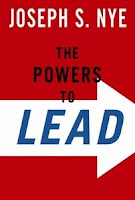 Good interview with Joseph Nye in the November issue of the Harvard Business Review (pp. 55-59). Mr. Nye is a professor at Harvard's JFK School of Government and the author of the books such as "Bound to Lead" and "The Powers to Lead."
Good interview with Joseph Nye in the November issue of the Harvard Business Review (pp. 55-59). Mr. Nye is a professor at Harvard's JFK School of Government and the author of the books such as "Bound to Lead" and "The Powers to Lead."His work has real relevance for coaches, who must work to get their teams to "buy in" to their vision and system.
According to Nye, "great leaders... know how to...exercise 'smart power,' through which they generate trust and mobilize people around forward-looking agendas."
Here's an excerpt of the interview with Professor Nye from the HBR, combined with an interview from June that I found on the Kennedy School website:
In essence, power is nothing more than the ability to affect others to get what you want, and that requires a set of tools. Some of these are tools of coercion or payment, or hard power, and some are tools of attraction, or soft power.
For individuals, charisma (emotional appeal), vision, and communication are key soft-power tools.
There are three skills that are most crucial in the exercise of soft power:
The first is emotional intelligence, the ability to control your own emotions and use them to reach out to others.
Second, the idea of composing a vision of the future that attracts others.
And third, communication skills including both rhetorical skills and also the ability to use non-verbal communication tools.
Those three crucial soft power skills have to be combined with hard power skills in organizations, in politics, and so forth. When we restrain our definition of leadership to only top-down, king of the mountain, we miss the crucial role of soft power in effective leadership.
An effective leader uses soft power to bring others to share his or her vision of where we should go. Now, that vision of where we should go may be partly developed by the leader in consultation with others. It may also be a vision which the leader has developed from his or her background, but the ability to persuade others that this is where they want to go is absolutely crucial.
One way to examine leadership is through a model in which most people lead from the middle. A leader in the middle has to think in terms of a compass. There’s a boss above them, sort of to the north, and they have no hard power with the boss; they have to persuade him or her.
But, frankly, they must also be able to get subordinates to buy into their vision, which is very difficult to do by coercion alone.
So persuasion as an aspect of soft power becomes particularly important. Most of us are really leaders from the middle. Very few of us have no boss above us and very few fail to require cooperation from people on either side of us.
With the exception of the Dalai Lama and perhaps a few others, it's hard to think of anybody who has been able to lead using soft power alone. On the other hand, we often talk about hard power while forgetting that attraction is a very powerful tool. Ignoring it is a mistake.
Working out how to combine hard and soft power depends on understanding the context. A large part of what I call contextual intelligence comes from experience, but there's more to it. Using the tools of power wisely requires both experience and analysis.
I prefer soft power to hard power. You can argue that soft power is slightly preferable to hard because it gives more freedom to the person who is its object.
Effective strategies in the real world are a mix of hard and soft power, and that combination of hard and soft power in effective ways is what I call “smart power.”
Far too often people think that hard power alone is sufficient. Some people equate soft power with winning over the “hearts and minds” of others, but to be effective you need to use a combination of both hard and soft power.
[Teddy] Roosevelt was the epitome of smart power: The combination of soft and hard power in the right mix in the appropriate context. He was acutely alert to the use of hard power. But he was also aware of the importance of soft power.



